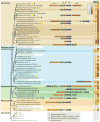General Stress Signaling in the Alphaproteobacteria
- PMID: 26442844
- PMCID: PMC4710059
- DOI: 10.1146/annurev-genet-112414-054813
General Stress Signaling in the Alphaproteobacteria
Abstract
The Alphaproteobacteria uniquely integrate features of two-component signal transduction and alternative σ factor regulation to control transcription of genes that ensure growth and survival across a range of stress conditions. Research over the past decade has led to the discovery of the key molecular players of this general stress response (GSR) system, including the sigma factor σ(EcfG), its anti-σ factor NepR, and the anti-anti-σ factor PhyR. The central molecular event of GSR activation entails aspartyl phosphorylation of PhyR, which promotes its binding to NepR and thereby releases σ(EcfG) to associate with RNAP and direct transcription. Recent studies are providing a new understanding of complex, multilayered sensory networks that activate and repress this central protein partner switch. This review synthesizes our structural and functional understanding of the core GSR regulatory proteins and highlights emerging data that are defining the systems that regulate GSR transcription in a variety of species.
Keywords: ECF sigma factor; HWE and HisKA_2 kinases; PhyR; partner switch; signal transduction; two-component signaling.
Figures





Similar articles
-
Extracytoplasmic Function σ Factors as Tools for Coordinating Stress Responses.Int J Mol Sci. 2021 Apr 9;22(8):3900. doi: 10.3390/ijms22083900. Int J Mol Sci. 2021. PMID: 33918849 Free PMC article. Review.
-
The general stress response in Alphaproteobacteria.Trends Microbiol. 2015 Mar;23(3):164-71. doi: 10.1016/j.tim.2014.12.006. Epub 2015 Jan 10. Trends Microbiol. 2015. PMID: 25582885 Review.
-
Structured and Dynamic Disordered Domains Regulate the Activity of a Multifunctional Anti-σ Factor.mBio. 2015 Jul 28;6(4):e00910. doi: 10.1128/mBio.00910-15. mBio. 2015. PMID: 26220965 Free PMC article.
-
Structural basis for sigma factor mimicry in the general stress response of Alphaproteobacteria.Proc Natl Acad Sci U S A. 2012 May 22;109(21):E1405-14. doi: 10.1073/pnas.1117003109. Epub 2012 May 1. Proc Natl Acad Sci U S A. 2012. PMID: 22550171 Free PMC article.
-
Complex two-component signaling regulates the general stress response in Alphaproteobacteria.Proc Natl Acad Sci U S A. 2014 Dec 2;111(48):E5196-204. doi: 10.1073/pnas.1410095111. Epub 2014 Nov 17. Proc Natl Acad Sci U S A. 2014. PMID: 25404331 Free PMC article.
Cited by
-
Bradyrhizobium diazoefficiens Requires Chemical Chaperones To Cope with Osmotic Stress during Soybean Infection.mBio. 2021 Mar 30;12(2):e00390-21. doi: 10.1128/mBio.00390-21. mBio. 2021. PMID: 33785618 Free PMC article.
-
Cross-regulation in a three-component cell envelope stress signaling system of Brucella.mBio. 2023 Dec 19;14(6):e0238723. doi: 10.1128/mbio.02387-23. Epub 2023 Nov 30. mBio. 2023. PMID: 38032291 Free PMC article.
-
Global Transcriptional Programs in Archaea Share Features with the Eukaryotic Environmental Stress Response.J Mol Biol. 2019 Sep 20;431(20):4147-4166. doi: 10.1016/j.jmb.2019.07.029. Epub 2019 Aug 19. J Mol Biol. 2019. PMID: 31437442 Free PMC article. Review.
-
Transcriptional analysis of genes involved in competitive nodulation in Bradyrhizobium diazoefficiens at the presence of soybean root exudates.Sci Rep. 2017 Sep 8;7(1):10946. doi: 10.1038/s41598-017-11372-0. Sci Rep. 2017. PMID: 28887528 Free PMC article.
-
Extracytoplasmic Function σ Factors as Tools for Coordinating Stress Responses.Int J Mol Sci. 2021 Apr 9;22(8):3900. doi: 10.3390/ijms22083900. Int J Mol Sci. 2021. PMID: 33918849 Free PMC article. Review.
References
-
- Akbar S, Lee SY, Boylan SA, Price CW. Two genes from Bacillus subtilis under the sole control of the general stress transcription factor σB. Microbiology. 1999;145(Pt. 5):1069–78. - PubMed
-
- Alvarez-Martinez CE, Lourenco RF, Baldini RL, Laub MT, Gomes SL. The ECF sigma factor σT is involved in osmotic and oxidative stress responses in Caulobacter crescentus. Mol Microbiol. 2007;66:1240–55. - PubMed
-
- Anantharaman V, Aravind L. The CHASE domain: a predicted ligand-binding module in plant cytokinin receptors and other eukaryotic and bacterial receptors. Trends Biochem Sci. 2001;26:579–82. - PubMed
Publication types
MeSH terms
Substances
Grants and funding
LinkOut - more resources
Full Text Sources
Other Literature Sources
Miscellaneous

